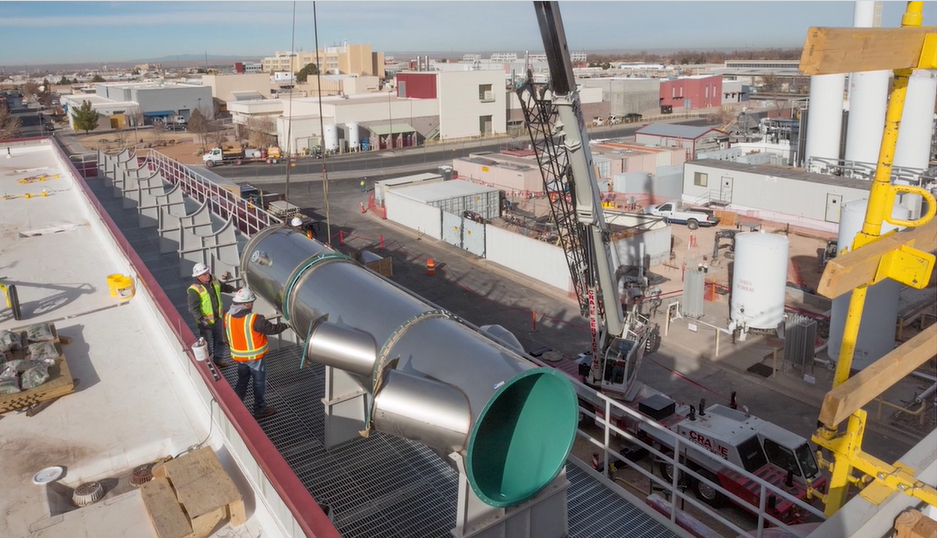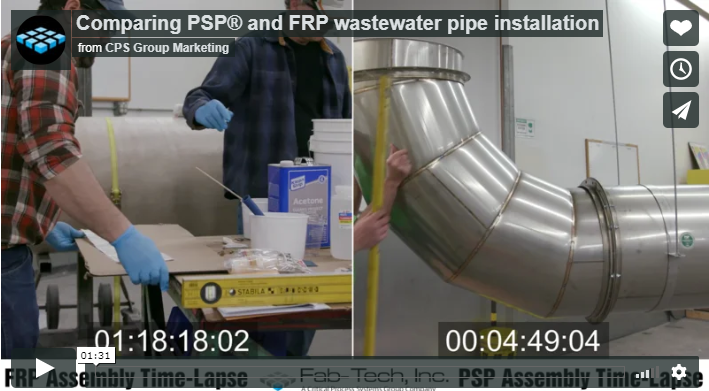Explanation of "Class 1" Building Materials
ASTM International (ASTM), originally known as the American Society for Testing and Materials, is an international standards organization that develops and publishes voluntary consensus technical standards for a wide range of materials, products, systems, and services.
Read More
Topics: class 1 duct
Sandia National Laboratories Bldg. 858N SW Acid Exhaust
A recent acid exhaust project where we supplied our PSP® to JB Henderson for an installation at Sandia National Labs was recognized for "outstanding specialty work" in an occupied and operational facility.
The project called for more than 2,000 linear feet of PSP fluoropolymer coated stainless steel duct to replace the existing weathered and contaminated FRP duct system.
Read More
Topics: fume exhaust duct, acid fumes, acid exhaust
PSP® Coated Metal Fume Exhaust Duct Excels Across Industries
Operational demands and safety requirements have driven a clear need for more chemically resistant and fire resistant fume exhaust systems among advanced process facilities. Exhaust duct systems in these environments must be able to chemically withstand highly corrosive process fume exhaust, not contribute to smoke or flame-spread in the event of a fire, and still stand up to any external environmental conditions or aggressive cleaning agents to which they may be exposed over the course of their lifecycle.
Read More
Topics: fume exhaust duct, lab safety
Coated Stainless Steel versus FRP Duct On Sustainability
We are entering a new age, one where people are realizing that it’s possible to meet and exceed business financial goals and to still make progress in preserving our environment. This concept is taking hold in new and diverse ways across many commercial and industrial spheres. It's known as the circular economy.
You’ll be hearing this phrase more and more as its influence grows, but what exactly does it mean?
Read More
Topics: frp duct, wastewater treatment plant odor control
MULTIPLE METHODS FOR SLUDGE DEWATERING BUT ONLY ONE ODOR CONTROL SOLUTION
Sludge dewatering is the process of removing as much water as possible from wastewater and sewage sludge. The output of this process includes untreated water that will continue to be cleaned and purified (before being released and reused), and biosolids with drastically reduced liquid content, volume and mass.
The reduced mass and volume of the biosolid end-product makes it far easier to store or transport, being both lighter and with a far smaller footprint. It is then either land applied as agricultural fertilizer or sent to a landfill.
Read More
Topics: wastewater treatment plant odor control, sludge dewatering
Importance of Ventilated Odor Control in Wastewater Biosolids Areas
Biosolids are a nutrient-rich organic material produced when sewage sludge is extracted from wastewater and treated with several processes, including one to reduce pathogens. It can have an organic matter content of up to 50% and is often used as an alternative to conventional fertilizer.
Read More
Topics: biosolids management, wastewater treatment plant odor control
4 Considerations for Wastewater Odor Control Technology
When odors from wastewater treatment facilities become problematic for surrounding communities, they have the potential to cause more headaches than simply an unpleasant smell. Depending on the severity of the foul air, locals may contact plant management to complain, or in more severe cases they may even reach out to local government or the media to make their complaints be known. If these odors begin to garner political or media attention it could hurt the reputation of the plant. Moreover, severe odors can impact job satisfaction and even the safety of on-site employees.
So, what can be done to control problem odors?
Read More
Topics: wastewater treatment plant odor control, odor control technology, odor control systems
Why Lab Ventilation Systems Should Use PSP® Fume Exhaust Duct
Fab-Tech’s proprietary fluoropolymer coated stainless steel fume exhaust duct carries clear benefits across an array of industrial and scientific research applications.
Given its status as the material of choice for venting corrosive fumes in semiconductor manufacturing, laboratory owners in private and university settings have taken note and are now following suit.
Read More
Topics: frp duct, fume exhaust duct, laboratory ventilation
Video Comparison of PSP® Vent Pipe and FRP Duct Assembly
A common belief among engineers and facility designers is that coated stainless steel vent pipe is more expensive than FRP duct alternatives. While the upfront material costs of fiberglass may appear slightly cheaper on estimates, it is most important to compare equivalent systems, such as the resin and service type of FRP duct, and to include an evaluation of system installation time and cost.
Read More
Topics: vent pipe installation, frp duct, duct installation
Differentiate Your Firm in Your Next WWTP Pitch
The AE marketplace gets more competitive every day. AE firms competing for the larger and more valuable WWTP projects must stay ahead of the competition or become commoditized.
It's not every day that an advanced process solution presents itself in the wastewater treatment market which provides so many benefits to operators and allows specifying engineers to stand out.
So, how can adding PermaShield Pipe to an AE firm’s toolbox help them stand out and stay innovative?
Read More
Topics: vent duct, facility design
PSP® Vent Duct Safely Handles Hydrochloric Acid Fumes
Belvidere, NJ - During the manufacture of a pilot run of innovative Vitamin C products, Roche Vitamins set out to solve a long standing problem that many pharmaceutical manufacturers and research labs face with their process ventilation systems.
That is, how to contain and convey highly corrosive acid exhaust without having to perpetually replace the vent duct system.
Read More
Topics: vent duct, acid fumes
5 Lab Design Criteria for the Future of U.S. National Labs
Governments around the world rely on their national labs to conduct research that will keep them at the leading edge of scientific and technological advancement.
Considering that U.S. national labs were developed during the middle of the 20th century and their management model is only recently showing signs of change, a major concern is that our national lab system may be many times inadequate to keep pace with modern day research initiatives.
Read More
Topics: lab design, national labs
PSP® Enhances lab Safety in State Of The Art MIT Nano-Complex
MIT is currently constructing a 200,000 square foot center for nanotechnology and nano-science at their campus in Cambridge, MA. Nicknamed MIT.nano, the facility will follow an open lab design concept to bring faculty, researchers and students together on a grand scale of collaboration.
Read More
Topics: fume exhaust duct, lab design, lab safety
A Closer Look At The Class 1 Fire Rating And ASTM E-84 Results of PSP® Fume Exhaust Duct
Prior to the appearance of 300 series fluoropolymer coated stainless steel, the most common materials for process ventilation were galvanized steel, polyvinyl chloride, polypropylene and FRP duct.
In today's high-cost high-tech process facilities, strong regulations and higher standards for fire-safety are turning the attention of facility owners, engineers, and underwriting insurers alike toward PSP® fluoropolymer coated fume exhaust duct.
To understand why, let's take a look at how PSP® gets its superior Class 1 fire rating.
Read More
Topics: frp duct, class 1 fire rating, astm e-84, class 1 duct
Fume Hood Safety Protocols Should Be In Lockstep with a Safe Lab Design
Fume hoods serve as the literal and figurative birthplace for next generation research and scientific discovery. Within these clean, confined spaces, our world is discovering new ways to improve the quality of life for all.
Thomas Edison was known to utilize his fireplace chimney as a fume vent. Without it, chances are his work would have ended prematurely.
These days, fume hoods are better ventilated, more chemically resistant, cleaner, and perform better than Edison’s fireplace, but they still require basic care and planning to ensure that lab safety is not compromised.
Read More
Topics: fume exhaust duct, lab design, lab safety
Here’s what it takes to make an exhaust duct joint on FRP Duct
Joints on FRP duct are traditionally accomplished by means of a labor intense "butt and wrap" procedure. Duct ends are ground smooth, exposed ends are sealed with catalyzed resin, and the duct or fitting is "buttered-up" and overlaid with several layers of resin and reinforcing fiberglass.
Adhesive curing at an ambient temperature of 70°F would take at least 24 hours to complete, so electric heating blankets are often required to accelerate the time to cure each joint.
Read More
Topics: frp duct, fume exhaust duct, duct installation
5 Advantages of A PSP® Fume Exhaust Duct Installation
Today, savvy wastewater treatment plant owners, engineers, and managers are paying close attention to the potential risks and unforeseen costs of the materials that are being used in their facilities and systems.
One area where material consideration can have both immediate and long lasting impacts is in the odor control systems of a wastewater treatment plant.
When it comes to exhaust duct installation, some materials like FRP duct may require a deep investment of time, money, and specialized labor.
Read More
Topics: frp duct, wastewater treatment plant odor control
Wet scrubber Systems and lab Fume Exhaust
Laboratories are becoming increasingly necessary as more and more products require the controlled conditions that only labs can provide. For the purposes of advanced manufacturing, every process from research, to testing, to development, to cleaning must be conducted with precision and accuracy.
Within these environments, lab fume hoods serve as an integral safety feature to help maintain facility air quality. While fume hoods are typically the first line of defense against hazardous vapors in these settings, they're by no means the only defense.
Read More
Topics: vent duct, research lab safety
Fluoropolymer Coating and Stainless Steel Fume Exhaust Duct Are a Perfect Combination
There's no shortage of corrosive fumes and vapors generated by process industries which need to be safely and successfully vented.
Common exhaust duct materials that are tasked with this responsibility include stainless steel, polyvinyl chloride (PVC), and fiberglass reinforced plastic (FRP). While special glass linings, metal alloys, and a wide range of polymers may be used individually or in combination to help meet particular demands, none seem to solve the breadth of corrosive application challenges like PermaShield Pipe (PSP®) with its proprietary fluoropolymer coating.
Read More
Topics: fluoropolymer coating, fume exhaust duct
5 Fundamentals For Dynamic Lab Air Quality Needs
In the face of exponentially changing technology and consumer demands, advanced manufacturing industries are driving research labs and clean rooms to accommodate multiple production flows.
As such, these facilities must contend with a wider spectrum of lab air quality requirements, including increased air supply, dynamic airflow patterns, room pressurization, and high-efficiency air filtration versus that of traditional labs and clean rooms.
Here we'll cover 5 fundamental lab air quality considerations that should be factored into every advanced manufacturing clean room or research lab design.
Read More
Topics: lab design, research lab, lab air
/Pharmaceutical%20Engineering%20Standards.jpeg)

/psp-fume-exhaust-duct-systems.png)
/wastewater-treatment-plant-circular-economy.jpg)
/PSP%20Coated%20Metal%20Duct%20at%20Brightwater%20WWTP%20(cropped).jpeg)
/DC%20Water%20Blue%20Plains%20PSP%20Installed.png)
/treatment-plant-wastewater-2826990_640.jpg)
/research%20lab%20fume%20exhaust%20duct.png)

/Permashield%20Pipe%20Vent%20Duct.png)
/corrosive%20acid%20and%20acid%20fumes.png)
/Lab%20Equipment%20Brookhaven%20National%20Laboratory.png)
/MIT%20clean%20room%20PSP%20exhaust%20duct%20system.png)
/MIT%20clean%20room%20PSP%20overhead%20exhast%20duct%20system.png)
/Lab%20fume%20hood%20experiment.png)







